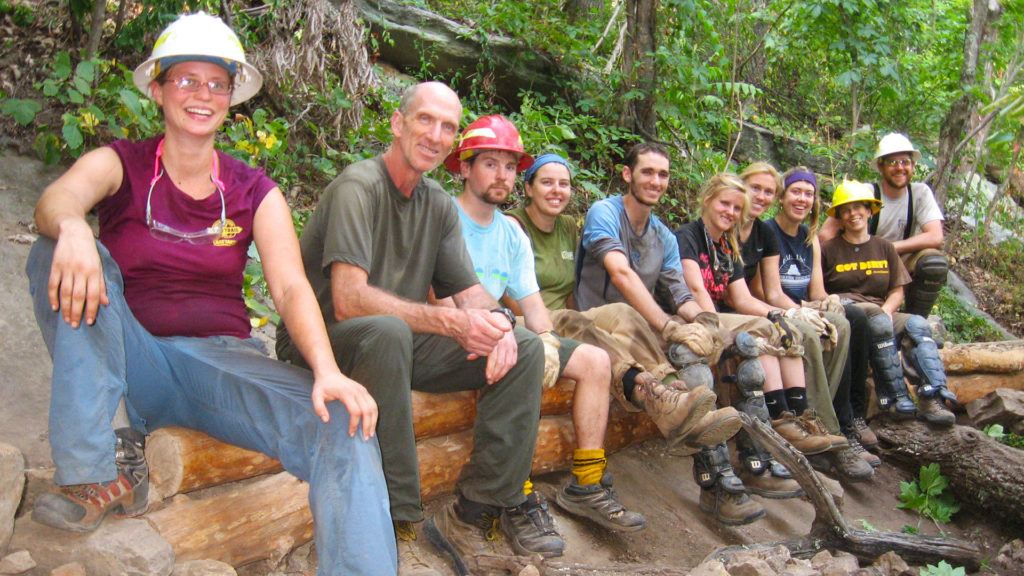by Lynsey “Stubbs” Abrams
Post Trail Depression: What it’s Like, How it Happens & How to Get Over It
October 18, 2018
As the Appalachian Trail Conservancy celebrates 100 years of keeping the Appalachian Trail alive, we’re working to literally redefine what it means to “take a hike.” Currently, this phrase is defined as a rude way of telling someone to leave, but we know that hiking helps improve the health of our bodies and minds. So, telling someone to take a hike is actually one of the kindest things you could say.
We invite you to sign the definition petition at takeahikepetition.org and share your story about how hiking — whether your days on trail or the weeks and months of reflection afterward — made a difference in your mental wellbeing.
Share your reflections about how the Trail made a difference in your mental health in 1,000 words or less for a chance to be featured on the ATC’s digital channels, or in our member magazine, A.T. Journeys.
You finished finished a long-distance hike. You just enjoyed some of the most amazing days of your life and it’s hit you that it’s all over. The solitude, companionship, the “eating-whatever-you-want” with no consequence, the body odor — all gone. In exchange you get responsibilities, stress, people who “just don’t get it” and the dilemma of adjusting to societal norms.
It may feel like grieving the loss of a loved one, and feeling nostalgia for the Trail resulting in overwhelming and lingering sadness over what was. You might feel a loss of purpose, a loss of interest in what you used to enjoy and a decrease in energy and motivation. This is called “post Trail depression,” and nearly everyone suffers from it upon returning home.
The Causes:
Financial Factors & Responsibilities
You used to sleep, eat and breathe hiking. Your whole life revolved around one huge goal. Now you have completely different tasks and problems to solve. You might have difficulty finding a job or housing. You may have gone broke and are struggling to make ends meet. There also may be dependents to return to and care for, or higher education to get coordinated. Trail life isn’t effortless, but worrying about things like, your next resupply or how many miles you plan on hiking for the day will seem like simple duties in hindsight compared to the more complex obligations of the “real world.”
Physical Factors
You aren’t receiving the same amount of endorphins as you were hiking all day, so your mood might resemble your summit: what goes up must come down. You also won’t be burning the same amount of calories and will have to exchange an “eating-everything-in-sight” diet to a reasonable one. If you’re returning due to an injury, staying really mobile isn’t an option. The transition from hiking many miles a day to parking it on the couch is frustrating in itself.
Friendship/Family Transition
The people you experienced everything with — from the pain of blistered feet and the suffering of being stranded out in the freezing rain with nothing dry to wear and nowhere dry to sleep, to the excitement of stumbling upon Trail Magic, to the elation experienced when you reach the summit with the most beautiful view you’ve ever seen — are no longer within walking distance. Sure, your friends and family are awesome, but they won’t be able to comprehend the smaller things you went through, let alone the heartache you’re experiencing now that it’s all over.
Personal Factors

Photo by “Imperial Skydiver”
You walked into the woods as one person and walked out a completely different one. You’ll likely look at things differently – from what’s considered relevant and necessary, like clothing, food and a roof over your head, rather than being able to binge watch your favorite TV show and always having Wi-Fi access, as well as what should be shrugged off, like other people’s negative opinions, judgements and obnoxious behaviors, versus what’s actually concerning, like overcoming debt, battling poor health and struggling to find your place back in the world. You’re like a puzzle piece that warped in the sun, no longer fitting in the picture the way you used to before you broke new ground on the A.T.
The Treatment:
Okay, so you’ve figured out that you have post Trail depression; that’s the easy part., Now comes the hard part: how do you fix it? There may not be a cure-all, but there are certainly ways to help move past it. Just remember, feelings like this typically don’t disappear overnight. Like hiking the Trail, however, putting one foot in front of the other will eventually lead you to where you need to go.
Self Care
Exercise releases those ever-important endorphins, keeping the body and mind feeling good. Staying active is also a healthy distraction, since you’re probably still battling that hiker hunger, too. Looking for some ways to stay active? Hit the gym, commit to going out for a run three or more times a week, take up rock climbing, yoga or paddling, or join a local sports league of your choice. You can always return to the Trail for a day hike, repeat or make-up a section, or take your backpacking excursion to a new and different trail if the A.T. isn’t close to home.
The A.T. was not just physical, but was also very goal-oriented. Another way to help you get out of that funk would be to work towards a new physical goal. Train for a foot race whether it’s a short fun run like a 5K, or something larger like a marathon or an ultramarathon. There are also triathlons if you prefer the variety, or you could enter a bike race or work your way up the ranks through martial arts.
Endorphins aside, you spent a lot of time inside your head while on trail. Make time to relive the solitude you once felt by spending some time by yourself so you can clear the noise. This can be done by sitting on a bench and people-watching for a few minutes, or through meditation in a quiet space indoors or outdoors; concentrate on your breathing or focus on a particular object to silence the mind. Meditation not only helps your mental health; there are many other health benefits that make it worth reserving a minute or two out of your day.
Stay Connected
You’re just a click away from your “tramily” (read: “Trail family”) through social media, so don’t be afraid to reach out! You’re not alone in this, and there are plenty of people out there who can relate. You can make plans to meet up with your trail family in person too. Meet somewhere in between, or make plans to meet in the near future and commit. At the very least, there’s always Trail Days to look forward to.
Give Back to the Trail

Every hiker has experienced one (or several) memorable situations that made a positive impact on their hike. Return the good karma: provide trail magic, like buying a hiker a slice of pizza in town or hiking in treats to share! Trail maintenance is another great way to increase your karma: contact a trail club to get involved or join one of the ATC’s Trail crews — you’ll be back on the Trail and helping protect the experience for future A.T. hikers.
Find a New Obsession
The A.T. was a huge goal that you spent a lot of time planning for. You’re likely working toward getting your personal life back in check, so try utilizing your downtime by focusing on smaller goals and achievements. Revisit an older passion or start a new hobby. You might have other trails in your crosshairs after the A.T., or maybe you want to move onto other fun adventures or a life milestone. No matter what your aspirations, these goals take planning and will keep you focused on something to look forward to instead of dwelling on the past.
Seek Professional Help
If you just feel absolutely helpless, remember that you’re not alone. Don’t be afraid to seek help from a professional. If it’s urgent, you can call 1-800-273-TALK (8255) for the National Suicide Prevention Lifeline.
Conclusion:
It may have started the moment you reached the summit. When you realized you were done what you had worked so long and hard to accomplish. It could have been during the return home. Maybe you were taking the bus back with your head resting on the window staring at the trees, and you abruptly became aware of the fact that you won’t have to walk through them tomorrow, or possibly ever. Maybe it hit you when you were sent home early because you got injured or sick. Or perhaps it was when everyone from home asked you, “how was it?” and “what was it like?”
Not everyone experiences “post trail depression” after a long hike, but some do and the struggle is real. Just know there are ways of making it easier to cope, whether it’s by getting those endorphins pumping again, reconnecting with your ‘tramily’ or the trail itself, or by keeping yourself engaged and concentrating on a new goal or adventure. You may have been a solo hiker, but just like your time on the Trail, you’ll never truly be alone while getting re-established unless you choose to be.
“You cannot stop the birds of sorrow from flying over your head, but you can stop them nesting in your hair.”
 Stubbs hiked the Appalachian Trail in 2016 and 2017. When she’s not hiking, she likes getting her passport stamped as much as possible. Check out her hiking/travel blog, Stubbs Rambles On.
Stubbs hiked the Appalachian Trail in 2016 and 2017. When she’s not hiking, she likes getting her passport stamped as much as possible. Check out her hiking/travel blog, Stubbs Rambles On.
Header image by Krista Mallette.
